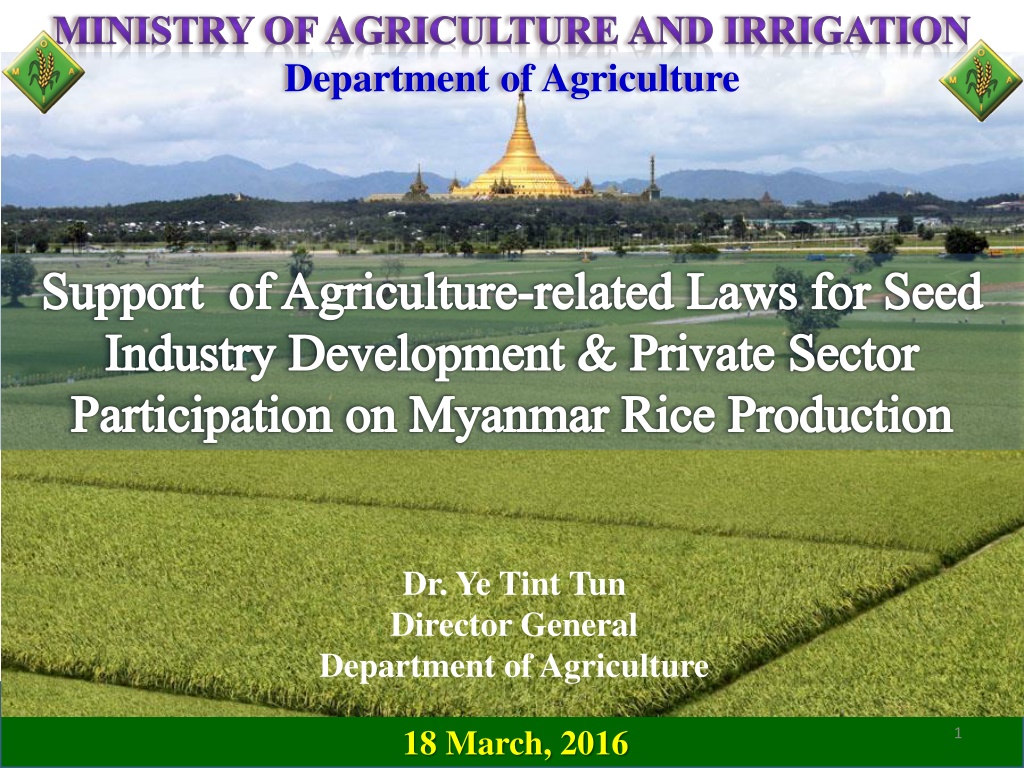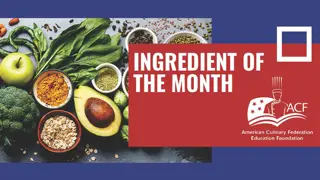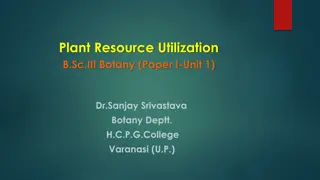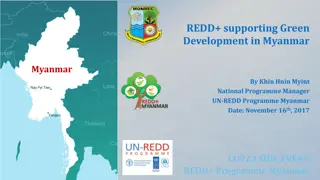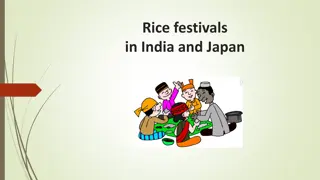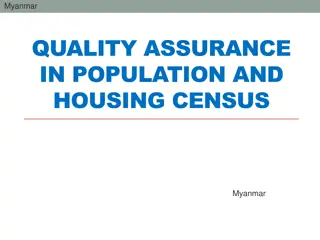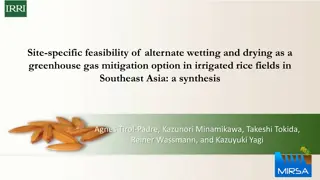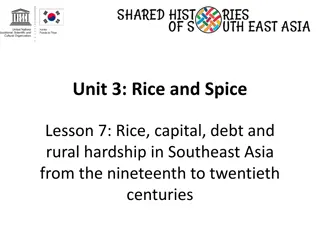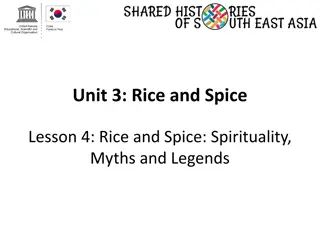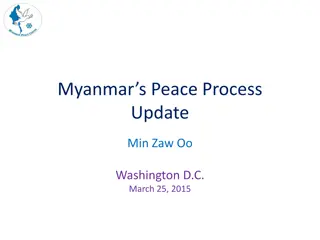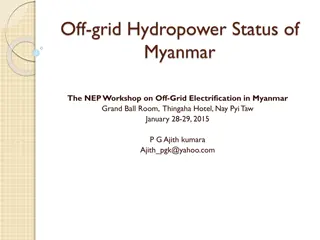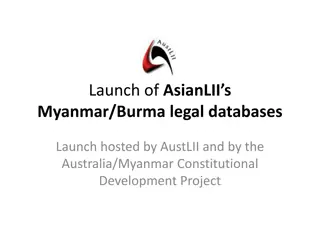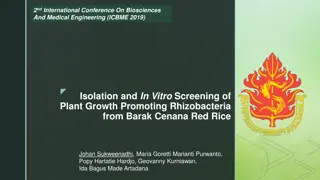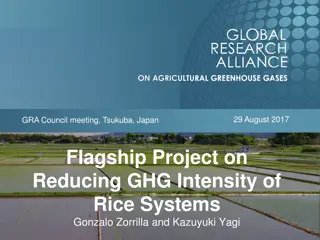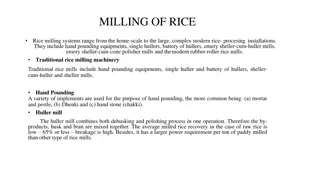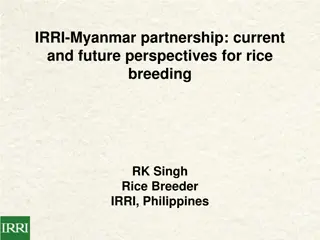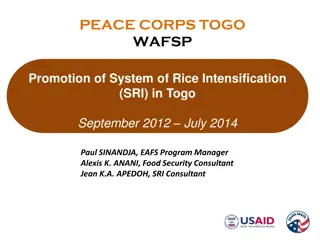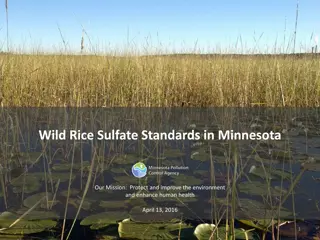Challenges and Opportunities in Myanmar Rice Production Industry
The demand for rice is on the rise globally, driven by population growth and changing consumption patterns. In Myanmar, various types of rice cultivation methods are practiced to meet the increasing demand. The country faces challenges in seed production and supply, with the need to bridge the gap between demand and availability. Major rice importing countries and trends in global rice consumption further highlight the significance of enhancing production and quality seed supply in Myanmar to contribute to the global rice market.
Download Presentation

Please find below an Image/Link to download the presentation.
The content on the website is provided AS IS for your information and personal use only. It may not be sold, licensed, or shared on other websites without obtaining consent from the author. Download presentation by click this link. If you encounter any issues during the download, it is possible that the publisher has removed the file from their server.
E N D
Presentation Transcript
MINISTRY OF AGRICULTURE AND IRRIGATION Department of Agriculture Support of Agriculture-related Laws for Seed Industry Development & Private Sector Participation on Myanmar Rice Production Dr. Ye Tint Tun Director General Department of Agriculture 18 March, 2016 1
Introduction Why Rice Demand is Growing World population will increase 9 Billion by 2050 Rice demand in traditional rice growing countries will continue to rise until they graduate to middle income country China's rice import may rise to 5-6 million tons in 2020 In China, 14 million tons goes for feed and 8 million tons for industrial use India's rice production would reach at the levels of 108 million tons by 2020 against its requirements of 118 million tons The demand for rice in Africa continues to increase, with an annual average importation of 2 million metric tons to fill the gap of production 2
Major Rice Importing Countries Mil Ton Source: Comtrade Saudi Arabia was the leading importer in 2014-15 followed by Iran and China 4
Different Type of Rice Cultivation in Myanmar Local 1.03% Hybrid rice 4.60% High Quality 1.32% High Yield 55.36% Hybrid rice 2.07% Local 21.33% High Yield 93.05% High Quality 21.24% Hybrid High Yield High Quality Local Hybrid High Yield High Quality Local Monsoon Rice Summer Rice 5
Harvested Area and production of Rice in Myanmar Total Rice Production 35000000 10000000 30000000 Production (MT) 9000000 25000000 Harvested area (Ha) 20000000 8000000 15000000 10000000 7000000 Hybrid Seed Production F1 Seed Production 1900 Production (MT) 1010000 180000 1600 Productio n (MT) 1400 1100 510000 130000 900 Harvested area (Ha) 600 Harvested area (Ha) 100 400 10000 80000 6
Quality Seed Demand and Supply in Myanmar Seed Demand 585365 Can provide only 25.72% of Demand (Ton) 561559 558275 558016 552937 2011-2012 2012-2013 2013-2014 2014-2015 2015-2016 CS Production RSProduction 150966 149222 2631 143533 2263 2165 2166 1987 96061 81596 920 35276 32721 32653 847 765 875 832 21568 17071 2011-2012 2012-2013 2013-2014 2014-2015 2015-2016 2011-2012 2012-2013 2013-2014 2014-2015 2015-2016 Production (MT) Sown (Ha) Producrtion(MT) Sown (Ha) 7
Major Rice Exporting Countries Myanmar Export Mil Ton 1.841 2 1.5 1.067 1.424 1.263 1 0.5 0.844 0 Mil Tons Source : Comtrade India was the largest exporter of rice in 2014-15 followed by Thailand and Vietnam and Pakistan 8
Efforts on Seed Industry Development Direct profit Seed Policy Seed Law Plant Varietal Protection law The Law of Protection of the farmer Rights and Enhancement of their Benefits Farmers Policy Laws Collaboration Private Support Fertilizer Law Plant Pest Quarantine Law Pesticide Law Farmland Law Virgin land law Public Regulations Seed is the vital and fundamental food source for human being
Myanmars Existing Laws and profit to private Sector Seed Policy To support the establishment of sustainable seed industry through systematic and strategic approaches Strategies: Encourage the private sector, to progressively expand its activities in certified seed production and marketing of the major crops, especially rice. (strategy _3) Support elevating private sector capacity in both research and foundation seed production at an acceptable level. (strategy_ 4) Undertake all steps and policy measures to gradually reduce the role of the public sector that the private seed sector would eventually dominate all aspects of the seed sector which lend themselves to commercial operations. (strategy_ 5) 10
Seed Policy Seed production The private sector will be free to produce FS from their own BS in line with the provisions of the Seed Law. (Sect 7 a, b) Seed conditioning and storage Service the spare capacity of existing seed plants to emerging private sector and encourage them to invest in this area to meet their own specific needs (Sect 8) Seed Market, Distribution and Export Government will assist the private sector for marketing and data source on seed demand, agro-ecological, needed facilities and other inputs (Sect_10-b, c) Farmers affected under emergency situations have to be assisted by Government (Sect_10-d) Government will support any private sector initiative that seeks to exploit the seed export potential. (Sect_12) Seed Sector Development provision of low-interest credit to establish seed processing facilities, reduced taxes on imported seed processing and handling machineries and equipment (Sect-13) Government will undertake appropriate measures to ensure that farmers get reasonable returns when they sell their produce.(Sect-13) 11
Seed Laws & Related Laws in Myanmar Title of Law or Regulation The Seed Law Responsible Agency MOAI No. Scope of Law or Regulation Status 1. Enacted 2011 To maintain quality and the use of seeds Intellectual property right of breeder To protect the farmers right MOAI 2. Plant Varietal protection Law Enacted 2016 MOAI The Law of Protection of the farmer Rights and Enhancement of their Benefits 3. Enacted 2013 MOAI Farmland Law 4. Enacted 2012 Right to use the Farmland MOAI Vacant, Fallow and Virgin Land Management Law Fertilizer Law Pesticide Law 5. Enacted 2012 Right to Cultivate or Utilize Vacant, Fallow and Virgin Lands MOAI MOAI MOAI 6. 7. 8. Enacted 2002 Enacted 1990 Enacted 1993 To manage the use of fertilizer Covers the use of pesticides To Prevent quarantine pests from entering into Myanmar Plant Pest Quarantine Law 12
Seed Law Enacted 2011, Amended 2015 Four objectives, one of them: Encourage for enabling the participation in seed production and carrying out seed research by individuals/private (sect 3-c) Formation of the National Seed Committee Experts and suitable persons are welcome as members of NSC (sect 4-a) Functions and Duties One of the duty and function of NSC is to carry out for the development of seed research works of organizations and individuals/private (sect 5-c) Cooperating with the Government and organizations, international organizations and individuals relating to seed business (sect 5-f) Quality Control Any person desirous of establishing the Seed Testing Laboratory shall apply to NSC (sect-12) Seed Business A person desirous of carrying out the seed business shall apply to TSC to obtain a license in accord with stipulations (sect 16-a) 13
Protection of New Plant Varieties Law Enacted 2016 Four Objectives, two of them: To protect new plant breeder right (sect 3-a) To increase both local and foreign investment in breeding for new plant (sect 3-c) Application for Protection of the Breeder Right The citizens, the foreigners and organizations (permanent resident in Myanmar), individuals and organizations from foreign countries (agreement for protection of the new plant variety) shall be allowed to make application for the right to protect of new plant variety (sect 15-a, b, c) Conditions to Protect the Right Plant breeder may have the right to acquire the plant parts to be harvested or whole of the harvested plant for doing matters if any person use the propagated parts of the protected plant variety without permission (sect 25) 14
The Law of Protection of the Farmer Rights and Enhancement of Their Benefits Enacted 2013 Duties and functions Assisting farmers to produce and sell profitable crops freely (sect 5-a) Educating the right choice of cropping pattern conformity with the region (sect 5-b) Arranging loan and assistance for the farmer when it is required for agricultural production (sect 5-c) Assisting to sell agricultural produces freely within the country and to export them legally (sect 5-d) Supporting modern technology and inputs for the development of agriculture and livestock breeding establishment and encouragement of research (sect 5-e) encourage development of standard private seed research works and private seed production (Sect 20-a) Linking with he market to get reasonable prices for agricultural produces of farmers. (sect 5-f) Coordinate with international organizations and regional organizations of each category of agricultural produce. (sect 5-g) connect with organizations for dissemination of market and price information to get local and foreign market (Sect 20-d) 15
Farmland Law Enacted 2012 Issue the certificate to use the farmland Person or organization after registration by paying registration fees in accord with the stipulations (sect 6) Right to use the farmland law Right to have the farmland in possession, right to use the farmland, right to enjoy the benefit arises from this right; (sect 9-a) Right to use common interest with investment By cooperating with private investors, village co-operative, foreigner or organization for development of agriculture in the farmland (sect 9-e & f) Confirming after scrutinizing the submission To use the farmland in constructing rice-mills, storehouses of crops etc., in changing over the system of manual to mechanized agriculture for the development of the agricultural sector; (sect 17-g) Application to alter originally cultivated crops to others: Permit to cultivate other crops in low land (paddy land) after scrutinizing in accord with the stipulations so as not to affect the sufficiency of rice which is the staple crop of the State and it is alter crops except low land as well (sect 28-a) Vacant, fallow and virgin lands The cultivation and production of crops is stable, alter and stipulate as the farmland and cause to involve in this Law (sect 34) 16
The Vacant, Fallow and Virgin Lands Management Law Enacted 2012 Right to Cultivate or Utilize Vacant, Fallow and Virgin Lands by the following persons: Myanmar citizen investors; investors, who obtained the permission to carry out the businesses of mutual benefit with any Government department or organization under the Foreign Investment Law; investors who obtained the permission to carry out the businesses of mutual benefit with investors of Myanmar citizen under the Foreign Investment Law. Stipulations Relating to the Right to Cultivate or Utilize Vacant, Fallow and Virgin Lands perennial plant and industrial seasonal crops, permit 5000 acres at a time. If 75 percent have been fully carried out, permit again not exceeding 5000 acres up to the total of 50000 acres time after time. If the business which should be permissible for the interest of the State, permit more than 5000 acres at a time with the approval of the Union Government. orchard, permit not exceeding 3000 acres. permit not exceeding 50 acres of vacant, fallow and virgin land for the rural cultivators and persons desirous of carrying out agriculture on manageable family- sized scale. 17
Myanmars Existing Laws and profit to private Sector Fertilizer law registration certificate for fertilizer production, importing or exporting as commercial purposes. allow compounding, mixing, repackaging, storing or distribution and sale of fertilizer as commercial purposes. Chance to get suitable experts to lay down the policy and guidance relating to the fertilizer business Pesticide law According to protect our surrounding pollution and prevent consumer and user health damage cause of agro- chemicals Any person desirous of importing formulated pesticides and active ingredients or export of the same must have one of the following registration/ use permit. An application in the prescribed form shall be submitted to the Registration Board. (Chapter 4.13) (a) experimental registration; (b) provisional registration; (c) full registration; (d) special use permit; Allow the application for License; (Chapter 5.17) pesticides formulation and sales in the country from imported active ingredients . re-packing and sale of imported pesticides, within the country. Fumigation License for export commodities , stored plants products, warehouse, buildings , containers and vehicle. Plant Pest Quarantine law To prevent quarantine pests from entering into Myanmar by any means.(Chapter 2.3(a)) To issue phytosanitary certificate for plant and plant product to be exported and import certificate for plant and plant product to be imported (Chapter 2.3(b)) 18
International Cooperation for Seed Development Projects Provided Organization World Bank No. Project Name Year 1. Seed Development Project Phase I 1978-1984 2. Seed Development Project Phase II 1986-1994 World Bank 3. Support to Special Rice production 2009-2012 FAO 4. Development of Participatory Multiplication and Distribution System for Quality Rice Seed Diversification and Intensification of Rice-based Cropping System in Lower Myanmar (My Rice) Support to the Development of Hybrid rice in Myanmar International Fund for Agriculture Development, FARM Project Agricultural Development Support Project 2011-2016 JICA 5. 2012-2015 IRRI, ACIAR 6. 2013-2015 FAO 7. 2014-2020 IFAD 8. 2016-2021 World Bank 19
Current Collaborative Private Companies 1. New Aye Yar Co.ltd 2. Great Wall Co.ltd 3. Shwe Nagar Min Co.ltd 4. Nine Sea Co.ltd 5. Yu Za Na Co.ltd 6. Dagon International Co.ltd 7. Zeyar Premiere Co.ltd 8. Green Asia Co.ltd 20
Challenges to Minimize Gap Poor collaboration and information sharing Low trusty between departments, private, organization and farmers Lagged of technology and human resource development Low infrastructures Development Physical & Technical Low interest to investment 21
Improve Collaboration and Trust to lay down the platform for Seed Association network Get Assistant from International and National Partners for HRD Raise Awareness for policy and laws More privatization on technology Establishment of Micro finance system for quality seed production Set up the model station with contract farming for C.S production Set the guarantee price for seed market Distribute the seeds to farmers with reasonable price Piling the revolving fund to keep the quality seed as reserved if emergency Win-Win Situation to all involvements. 22
Conclusion Myanmar needs to open up for private sector involvement in Agriculture sector. National and International partners should invest the Agriculture sector as long term project. Private sector should look at win-win situation in Agriculture sector. Participation of farmers and their awareness is very important and urgently need to improve. The policy, law and regulation should be flexible and easy to amend with situation. Also should be uniform with international standard. Government sector implementing alone is heavy load for many seed class production and planning hand over to private sector. Technology and human resource is available but need to upgrade with international standard. 23
